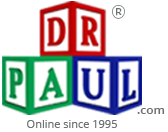Pneumonia means an infection of the lungs. In the early 1900’s pneumonia was responsible for many deaths even in children. Fortunately, with the invention of antibiotics and certain vaccines, pneumonia occurs less commonly today and can be effectively treated in most cases.
What causes pneumonia?
There are several types of germs that can cause an infection of the lungs; bacterial and viral. Although there are many different types of bacteria and viruses that can cause pneumonia, there tend to be related to age and other circumstances. For example the bacteria that cause pneumonia in newborns differ than those that cause the same infection in older children. Similarly, seemingly harmless germs may cause a pneumonia in persons with weakened immune or defence systems. These same germs would however cause no problem in persons who are healthy.
What are the symptoms of pneumonia?
The symptoms of pneumonia in children depend on the age. In younger children, it may be just fever or irritability. At any age there can be the “non specific” symptoms such as irritability and decreased appetite or feeding without any specific respiratory or chest symptoms. In , newborns, a specific type of pneumonia(group B Strep) can present soon after birth with difficulty breathing. As children get older, the symptoms of pneumonia become more specific including:
- Cough
- Fever
- Difficulty breathing
 IMPORTANT POINT: in some children persistent high fever(more than 4 days) can be the only sign of pneumonia. How is pneumonia confirmed? Although the doctor can sometimes hear specific noises with stethoscopes, that suggest pneumonia, the diagnosis is absolutely confirmed by a chest x-ray. As a matter of fact, in children, the chest X-ray can be abnormal, even if the chest examination is normal.
IMPORTANT POINT: in some children persistent high fever(more than 4 days) can be the only sign of pneumonia. How is pneumonia confirmed? Although the doctor can sometimes hear specific noises with stethoscopes, that suggest pneumonia, the diagnosis is absolutely confirmed by a chest x-ray. As a matter of fact, in children, the chest X-ray can be abnormal, even if the chest examination is normal.
How is pneumonia treated?
For viral pneumonia there is no treatment, although in most cases the doctor cannot tell if the cause is viral and will treat all pneumonias with antibiotics. Which antibiotic and how it is administered, depends on the age of the child and overall condition of the child. In general, children less than 3 months of age with pneumonia are admitted to hospital for intravenous antibiotics, oxygen treatment and rehydration as they tend to be dehydrated. Of course children with weakened immune systems are usually hospitalized and may need different(stronger) antibiotics than the children with normal immune systems. In older children, who are well otherwise, are drinking well and do not need oxygen, antibiotics, taken by mouth are prescribed that can be given at home. During the first 48 hours of antibiotics the child is still considered contagious and still may have fever. In this case, acetaminophen can be given for the fever as needed, according to the age and weight of the child. If after 48 hours of antibiotics the child is still has fever or is not getting better, the child should be re-examined by a doctor.
What happens after treatment?
After the full treatment course, children usually fully recover and there is no need to repeat the chest X-ray in typical non-complicated cases. However if the child was very ill, had a large or severe pneumonia, a repeat chest x ray may be recommended to make sure the pneumonia has cleared. If this is the case, a repeat X ray is performed 6-8 weeks later.
Recurrent pneumonia
Fortunately most children recover fully and do not have repeated episodes of pneumonia. However if a child has recurrent pneumonia this may be as sign of an underlying medical problem including weakened immune system, foreign body aspiration(having aspirated or choked on something that lodges in the lungs or bronchial tubes), or a structural defect of the lungs or bronchi. Obviously in such situations both the treatment and follow up approach would be different than for the typical pneumonia in a normal child. Specific tests including blood tests, sweat chloride, CT scans and other investigations may be necessary.
